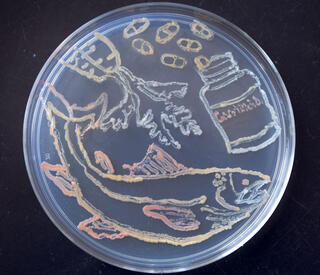Multitasking microbes could improve biofuel economics, climate impact

Genetically modified bacteria brews two valuable products from underutilized plant fiber.
The Science
Lignin is a major part of plant cells that makes them strong and rigid. It is made of compounds known as aromatics strung together in chains. Scientists have engineered microbes that can funnel these aromatics into single chemicals used to make plastics and other valuable chemicals. New research shows that one bacterium can be modified to simultaneously produce two valuable compounds from pretreated sorghum biomass: carotenoids, a group of organic pigments used in nutritional supplements, drugs, and cosmetics; and an acid called PDC that can be used to make plastics. The bacteria accumulate carotenoids within their cells, while they secrete PDC from the cells, providing two valuable products that can be easily separated in a single batch.
The Impact
Lignin is the world’s largest renewable source of aromatic carbon, but the complex and irregular structure makes it hard to break apart into useful components, and most industrial microbes cannot process the mix of aromatics in lignin that has been treated with chemicals to separate it from plant sugars. Converting this abundant raw material into valuable products is one of the keys to making plant-based products a cost-competitive alternative to fossil fuels and petrochemicals, which contribute to climate change. Using microbes to produce multiple products in a single batch could make biorefineries more sustainable and economically viable.
Summary
Scientists with the Great Lakes Bioenergy Research Center showed that a strain of Novosphingobium aromaticivorans naturally produces the carotenoid nostoxanthin. By deleting or adding selected genes, they engineered strains that produced the valuable carotenoids β-carotene, lycopene, zeaxanthin, and astaxanthin. They showed that these engineered strains produced carotenoids at comparable levels when grown either in laboratory media or in alkaline-pretreated sorghum biomass, which contains a mixture of aromatics.
Finally, they engineered strains that when grown on sorghum liquor produced zeaxanthin, beta-carotene, or astaxanthin concurrently with 2-pyrone-4,6-dicarboxylic acid (PDC), a potential building block for biodegradable polymers. Combined, the results show that N. aromaticivorans can simultaneously produce valuable intracellular and extracellular commodities when grown in the presence of either pure aromatics or pretreated lignocellulosic biomass.
Contact
Timothy Donohue
University of Wisconsin–Madison
tdonohue@bact.wisc.edu